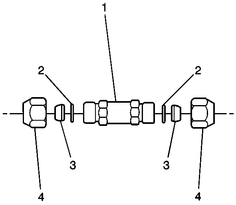Chevrolet Captiva Service & Repair Manual: Refrigerant Filter, Replace
| Caution: Air conditioning R-134a
liquid refrigerant is capable of harming eyes or freezing skin. Always wear
safety goggles and avoid contact with liquid refrigerant. Failure to follow
these instructions may result in serious personal injury. |
| Caution: Air conditioning R-134a
refrigerant gas is capable of displacing the air required for breathing
in a confined space and can produce toxic gasses if burned at high temperatures.
Do not release a large quantity of R-134a gas within a confined space or
allow it to be exposed to a high temperature flame (such as a torch). Consult
the Material Safety Data Sheet for further information. Failure to follow
these instructions may result in serious personal injury or death. |
| Caution: Use extreme care and
observe all safety and service precautions related to the use of refrigerants
as outlined on refrigerant tank and on recovery and charging equipment.
Failure to follow these instructions may result in serious personal injury. |
| Your vehicles air conditioning
system relies on A/C compressor oil to be circulated throughout the system
and maintain compressor lubrication. In fact, the A/C compressor and the
seals are the only reason for A/C oil. There are no other components that
require lubrication, and on orifice tube systems, the A/C compressor is
the only moving component. |
| When the air conditioning system
starts to get contaminated, harmful acids are formed. Those acids cause
corrosion and debris. That corrosion easily can restrict an orifice tube
or expansion valve. When that happens, the flow of oil to your compressor
stops. |
Removal
| 1. |
Recover air conditioning refrigerant
with a suitable air conditioning station. |
| 2. |
Remove front evaporator tube. |
| 3. |
Remove nuts (4) from A/C refrigerant
filter (1). Nuts (4) and ferrules (3) will remain on condenser tube.
Do not try to remove, Fig. 1. |
| 4. |
Remove A/C refrigerant filter from
condenser tube. |
|
Installation
| 1. |
Install O-rings as outlined in "Refrigerant
Line O-Ring, Replace." |
| 2. |
Install A/C refrigerant filter to condenser
tube with flow arrow pointing towards evaporator. |
| 3. |
Install nuts to A/C refrigerant filter. |
| 4. |
Install front evaporator tube. |
| 5. |
Evacuate and recharge A/C system. |
| 6. |
Leak test fittings of installed component
with halogen leak detector tool No. J-39400-A, or equivalent. |
|

Fig.
1 Refrigerant filter removal
Replacing the refrigerant filter in a Chevrolet Captiva's air conditioning system is a meticulous task that requires precision and adherence to safety protocols. Begin by parking the vehicle on a level surface and allowing the engine and components to cool down. Locate the refrigerant filter within the air conditioning system, typically situated near the condenser or evaporator unit, and consult the service manual or diagrams for precise guidance.
Evacuating the refrigerant from the system is the next crucial step, which should be performed by a certified technician with the appropriate equipment and knowledge of refrigerant handling. Once the refrigerant is safely evacuated, carefully remove the old filter, noting its orientation and any seals or O-rings that may require replacement. Install the new filter correctly, ensuring a secure fit and proper sealing. Recharge the air conditioning system with the recommended refrigerant type and quantity, and test the system for optimal cooling performance while inspecting for any leaks or irregularities. This meticulous approach ensures the efficient and safe replacement of the refrigerant filter in your Captiva's air conditioning system.
1.
Disconnect electrical connector from
blower motor control module.
2.
Remove blower control module bolts
from HVAC module, Fig. 1 ...
Caution: Air conditioning R-134a
liquid refrigerant is capable of harming eyes or freezing skin. Always wear
safety goggles and avoid contact with liquid refrigerant. Failure to follow ...

 HVAC Blower Motor Resistor R&R
HVAC Blower Motor Resistor R&R Refrigerant Line O-Ring, Replace
Refrigerant Line O-Ring, Replace